How to Go Bold With Summer Garden Color
http://decor-ideas.org 08/19/2013 12:25 Decor Ideas
If you take a walk around your neighborhood on a summer afternoon, you'll find that some gardens stand out from the rest. Some gardeners get your attention by using bold colors that stand out in the harsh sunlight, while others take advantage of large-leaved tropical plants that stand out even from the comfort of an air-conditioned car.
While you're window-shopping for ideas, note what appeals to you and what you can do in your own garden. Here are some design ideas to watch for while summer plantings are in their prime. Fall is a great time to get many of these plants in the ground.
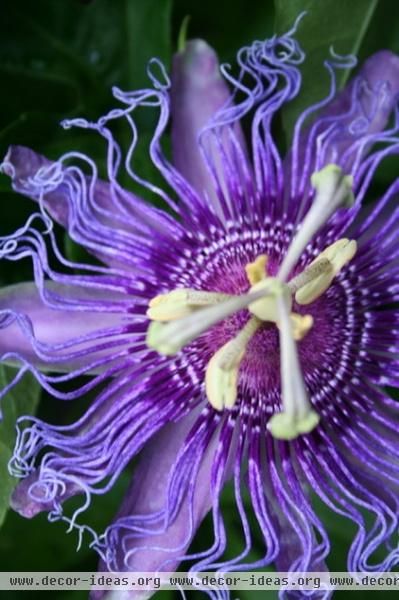
1. Cool down with cooling colors. Blue and purple do two wonderful things to a garden. They make a space seem cooler, because they appear to recede and become shadows. And as if making the garden feel cooler weren't a nice enough party trick, cool hues also make hot colors, like red and orange, stand out even more. This tip is especially useful during the hotter months, but can also be used to add interest in fall.
One way to make a garden seem bigger is to place cool colors in the back of your garden beds, especially paired with hot colors. You could use tall perennials, like purple coneflowers (Echinacea spp) and Mexican bush sage (Salvia leucantha, zones 8 to 11; annual elsewhere), or cover fences with vines like purple passionflower (Passiflora 'Incense', shown) or clematis (Clematis 'Jackmanii', zones 4 to 8).
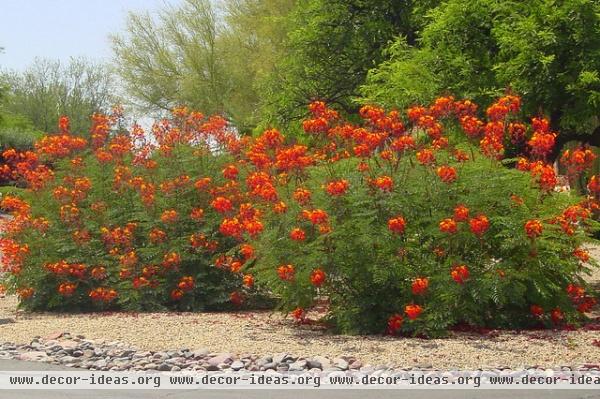
2. Spice it up with orange and red flowers. Warm colors have to be pretty intense in the glaring sun of summer, so skip the pastels and bring out your richest reds and most outrageous oranges.
This planting of red bird-of-paradise (Caesalpinia pulcherrima, zones 8 to 11) steals the show in a hot desert garden like the one shown here, but gardeners who receive freezes can get the same look with nasturtium (Tropaeolum majus, annual in all zones), crocosmia (Crocosmia crocosmiiflora, zones 5 to 9) or red hot poker (Kniphofia uvaria, zones 6 to 9).
For the most dramatic contrast, plant hot red flowers in front of cooler colors, such as the blue of the fine needles of Colorado blue spruce (Picea pungens, zones 2 to 7) or the deep purple of thundercloud plums (Prunus cerasifera, zones 5 to 8) or loropetalum (Loropetalum chinensis, zones 7 to 9).
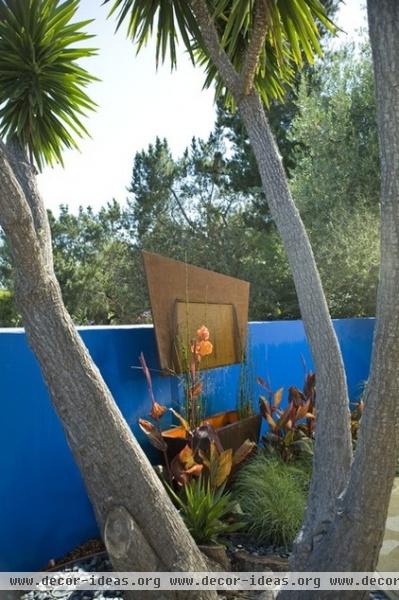
3. Create striking contrasts with painted backdrops. A brightly painted backdrop remains interesting throughout the year and makes adjacent plants pop. You can paint fences, trellises, garden walls or even the exterior of your home with reckless abandon, but your neighbors will probably prefer that you keep your loud colors to the backyard.
Other benefits to painting backdrops are that you can then easily distract from eyesores beyond the property line and give the eye a place to rest. This is especially helpful in a small space, where a collection of colorful flowers might seem a little cluttered.
Try to imagine how your chosen color will look at different times of the year, especially if your spring flowerbeds will clash. When you do make a decision, talk to a knowledgeable member of your local hardware store's staff to see what type of paint is appropriate for the job.
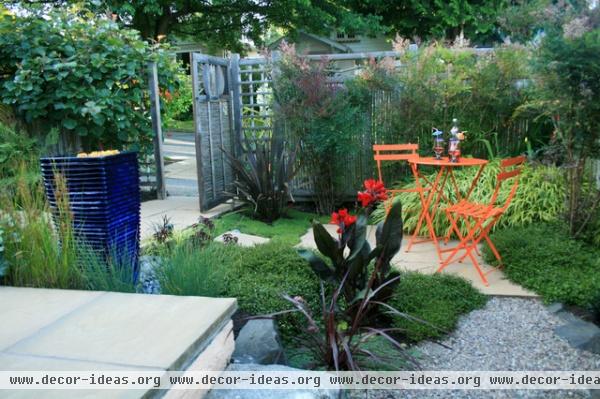
4. Bring new life to the garden with colorful furniture. If painting an entire wall or fence seems too extreme for your tastes, you can easily achieve a similar effect by purchasing colorful patio furniture or by giving tired old pieces a cheery facelift.
The table and chairs in the photo here avoid sticking out like sore orange thumbs because the designer was careful to pair them with a bright red-orange blooming canna (Canna 'Australia', all zones as a bulb) as well as a smattering of other orange flowers in a sea of green foliage. A large glazed ceramic pot in a complementary hue of cobalt blue adds a welcome pop of color and balances the composition with class.
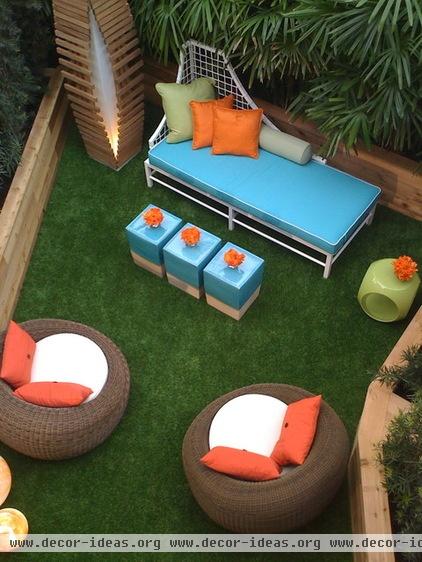
5. Accessorize with color. Another way to give your garden furniture a breath of fresh air this summer is to get a new set of pillows or cushions. This mod masterpiece by David Bromstad has lively hues of aquamarine and tangerine that perk up a small outdoor space without even a single flower's being used.
By making the furniture the most interesting part of an outdoor space, you'll draw visitors to the seating area where the party takes place. It couldn't hurt to give guests something to talk about, though, so incorporate plantings that will be in flower when you're most likely to entertain outdoors — summer. In this garden, adding highlights of lime green to chartreuse foliage would create interest, while plugging in some bright orange flowers would add excitement while keeping harmonious with the seating.
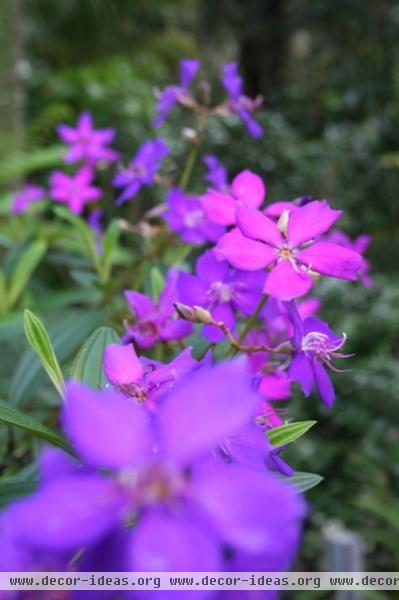
6. Bring in some shrubbery. Rather than just plant a bunch of run-of-the-mill summer bedding plants, why not seek a shrub that will bring even more dramatic blooms to the table? Even though they take up more space than bedding plants, shrubs are still superb choices for small gardens or entertaining areas because they raise the garden up and bring the blooms to eye level. You might even find some on clearance in the fall, as garden centers try to make room for fall plants and jack-o'-lanterns.
For big blooms and tropical personality, try hibiscus and its temperate relatives. Mallows such as confederate rose or the native swamp hibiscus are tall and ungainly but have absolutely enormous blooms that resemble the flowers of their relative, the hibiscus.
Princess flower (Tibouchina urvilleana, zones 9 to 11), shown here, can put you in a predicament, because it has velvety foliage that begs to be grown within arm's reach, but its cool purple flowers are also perfect for the back of a border. The solution is simple: Plant two.
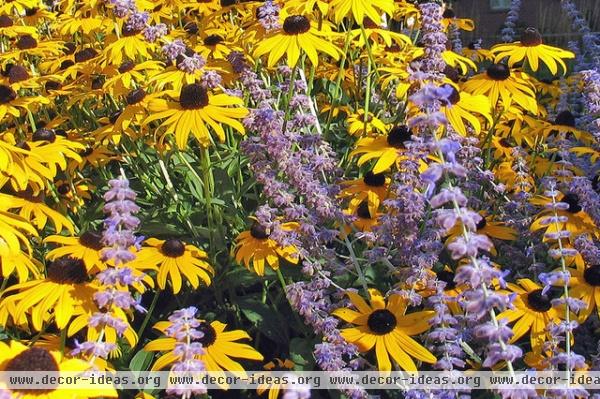
7. Combine cool and warm colors. Pairing up two colors that sit across from each other on the color wheel will make them appear to vibrate and dance in the lightest breeze. The lavender spires of Russian sage and joyful yellow sunbursts of black-eyed Susan in the photo here keep the eyes moving around the garden and seem to glimmer from a distance.
It's a neat trick and can be accomplished by juxtaposing blue and orange, or red and green, which is convenient since most leaves are green. To really make red flowers pop, use lighter hues of green, like lime or chartreuese. Golden Japanese forest grass (Hakonechloa macra 'Aureola', zones 5 to 9) and Marguerite sweet potato vine (Ipomoea batatas 'Marguerite', zones 9 to 11) are the perfect foils for a planting of red flowers.
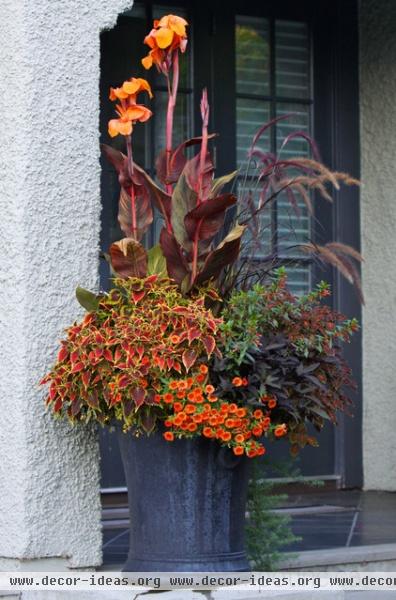
8. Make a temporary focal point. Rather than plant a whole bed of flowers, plant a container garden so that it can bring summer color where it's most appreciated — whether that's on a patio or a doorstep. Since container combinations are typically seasonal affairs, they're often planted with the desired flowers and dismantled or thrown out when the season is over.
A container planting with rich, warm hues, like the one shown here, will remain seasonally appropriate even when the frosty nights insist you bring it indoors and the trees' fall foliage encourages you to keep it outdoors just a little bit longer. You can also swap out frost-tender tropical plants in an arrangement like this with cold-hardier ones, like creeping bugleweed (Ajuga reptans, zones 3 to 9) or coral bells (Heuchera sanguinea, zones 4 to 9) to keep the show going into winter.
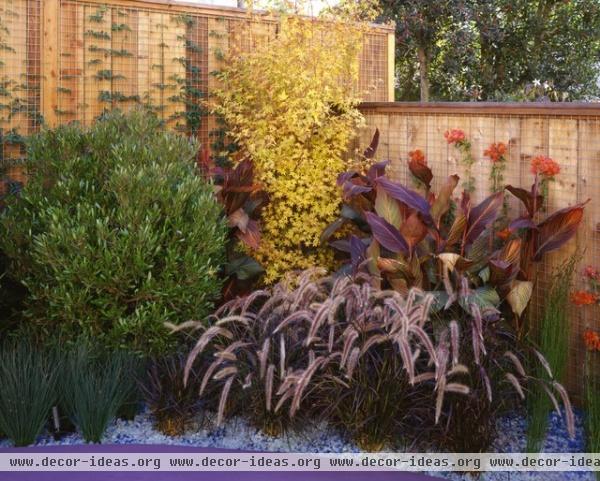
9. Plan ahead for fall. A bold planting of red-flowered and purple-leaved cannas certainly draws attention in summer, but remember that some of the colorful tropicals in the garden will start to fade as the weather cools down. Like the aforementioned container garden, mixing in a few plants with fall interest will keep your garden beds colorful as the days get colder.
Include plants that provide late-season interest, such as deciduous shrubs with intense fall colors or grasses like the purple fountain grass (Pennisetum setaceum 'Rubrum', zones 8 to 11) shown here. Even once frost kills the leaves, the plants will still hold their shape until spring.
More: What to Do in Your Garden Now
Related Articles Recommended












